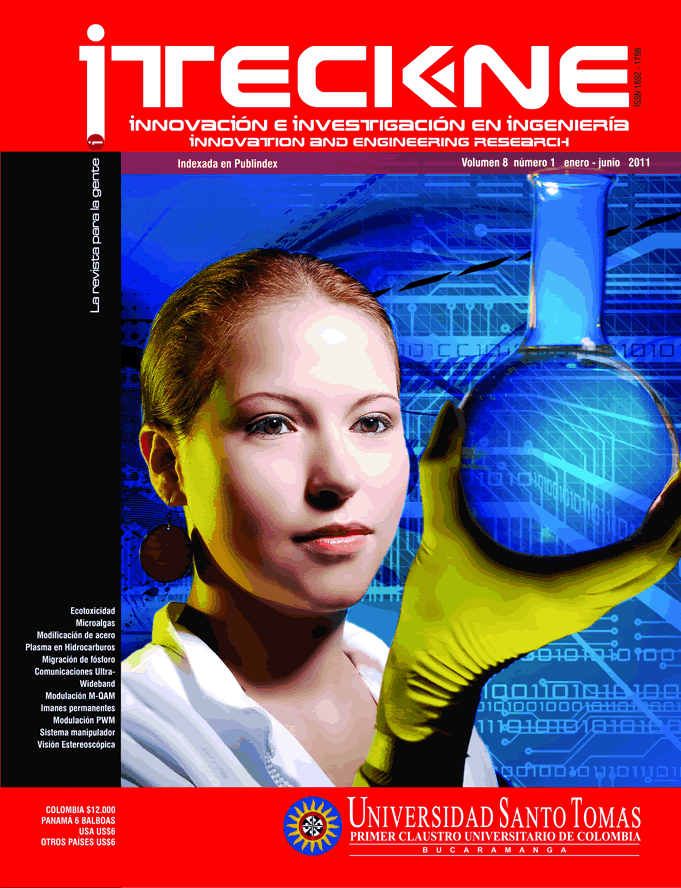A method of analysis by simulation of the M-QAM modulation over a channel affected by fading and Doppler effect
Abstract
En el artículo se presenta la metodología para determinar el desempeño de un sistema de comunicaciones digitales conformado por una modulación M-QAM (M-ary Quadrature Amplitude Modulation) afectado por un canal con desvanecimiento multi-trayectoria plano y lento tipo Rayleigh y un ruido Gassiano limitado en banda, por medio de la técnica de simulación por la envolvente compleja. Los resultados obtenidos son validados con algunas cotas de las probabilidades de error teóricas simplificadas para este tipo de modulaciones y canales. La metodología establece un procedimiento sistemático para encontrar las curvas de desempeño que caracterizan al sistema de comunicaciones bajo las condiciones no idealizadas del canal, las cuales permiten calcular los radio enlaces de los sistemas modernos como LTE (Long Term Evolution) y la televisión digital DVB-T.
Downloads
References
[2] K. Feher, Wireless Digital Communications: Modulation and Spread Spectrum Applications, May 1995
[3] W. Webb and R. Steele, “Variable rate QAM for mobile radio”, IEEE Transactions on Communications, vol.43, no.7, pp.2223-2230, Jul 1995
[4] S. Benedetto and E. Biglieri, Principles of Digital Transmission: With Wireless Applications, Kluwer Academic Pub, 1999
[5] S. Haykin. Communications Systems, Fourth Edition, John Willey & Sons, Inc, 2002
[6] J. Proakis, Digital Communications, Mc Graw Hill 2004
[7] K.S. Shanmugan, “Simulation and Implementation Tools for Signal Processing and Communication Systems,” IEEE Communications Magazine, vol.32, no.7, pp.36-40, Jul 1994
[8] W.H. Tranter and K.L. Kosbar, “Simulation of Communication Systems,” Communications Magazine, IEEE , vol.32, no.7, pp.26-35, Jul 1994
[9] B. Woerner, J.H. Reed and T. Rappaport, “Simulation Issues for Future Wireless Modems,” IEEE Communications Magazine, vol.32, no.7, pp.42- 53, Jul 1994
[10] A. Goldsmith, Wireless Communications, Cambridge University Press 2005
[11] T.S. Rappaport. Wireless Communications, Prentice Hall Communications Engineering and Emerging Technologies Series, New Jersey, 1996
[12] E. Biblieri, “Digital transmission in the 21st Century: Conflating Modulation and Coding”, Communications Magazine, IEEE , vol.40, no.5, pp.128-137, May 2002
[13] D.J. Gibson, The Communications Handbook, Editor in Chief. Second Edition CRC Press, 2002
[14] B. Sklar, “Rayleigh Fading Channels in Mobile Digital Communication Systems I. Characterization,” IEEE Communications Magazine, vol.35, no.7, pp.90-100, Jul 1997
[15] M. Pätzold, R. Garcia and F. Laue, “Design of High-Speed Simulation Models for Mobile Fading Channels by Using Table Look-Up Techniques,” IEEE Transactions on Vehicular Technology, vol.49, no.4, pp.1178-1190, Jul 2000
[16] R. H. Clarke, “A Statistical Theory of Mobile Radio Reception,“ Bell Systems Technical Journal, Vol. 47 pp. 957 – 1000, 1968
[17] W. Tranter, K.S. Shanmugan, T. Rappaport and K. Kosbar, Principles of Communication Systems Simulation with Wireless Applications, Prentice Hall. 2004
[18] C.A. Gutierrez, M. Cabrera and J. Sanchez, “Generation of correlated rayleigh-fading envelopes for simulating the variant behavior of indoor radio propagation channels,” Vehicular Technology Conference, vol.6, no., pp. 4245- 4249, Sept, 2004
[19] L. Hanzo, W. Webb, T. Keller. Single and MultiCarrier Quadrature Amplitude Modulation: Principles and Applications for Personal Communcations, WLANs and Broadcasting. Willey Chichester, 2000
[20] X. Tang, M. Alouini, and A. Goldsmith, “Effect of Channel Estimation Error on M-QAM BER Performance in Rayleigh Fading”, IEEE Transactions on Communications, vol.47, no.12, pp.1856-1864, Dec 1999.



















